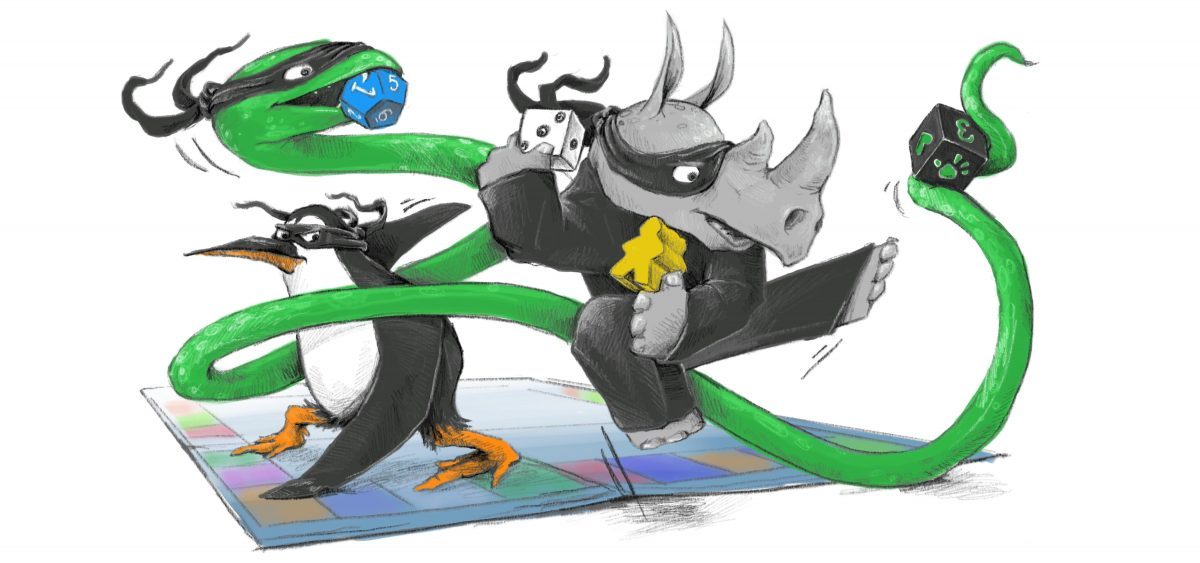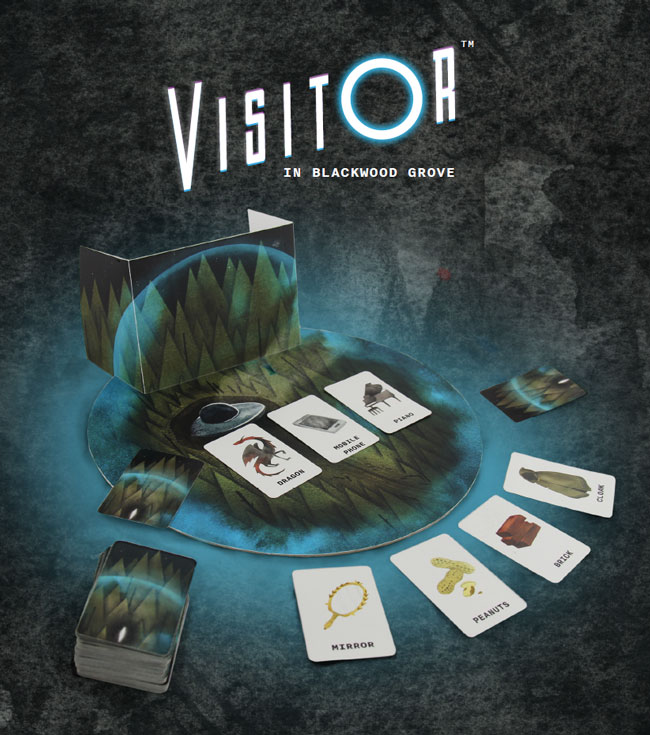There is a crashed Alien ship in Blackwood Grove. Everyone has seen it and everyone is doing their best to capture the alien (definitely not looking out for its well being). Everyone that is except some Kid who has stumbled across the scene and it actually trying to help. Whichever group gets through the forcefield first will determine the fate of the Visitor (and also the winner of the game). To do that they have to determine what the rule is that governs what gets through the forcefield. Will you play as the Alien trying to get back home, the Kid trying to help him escape or the Feds trying to capture the Alien and study it or do who knows what.
Sounds like fun, right? Let’s check it out.
First thing we have to do is determine what roles everyone is going to play. It’s helpful for someone who has played before to be the Visitor, but not at all necessary. Someone plays the Visitor and someone plays the Kid. 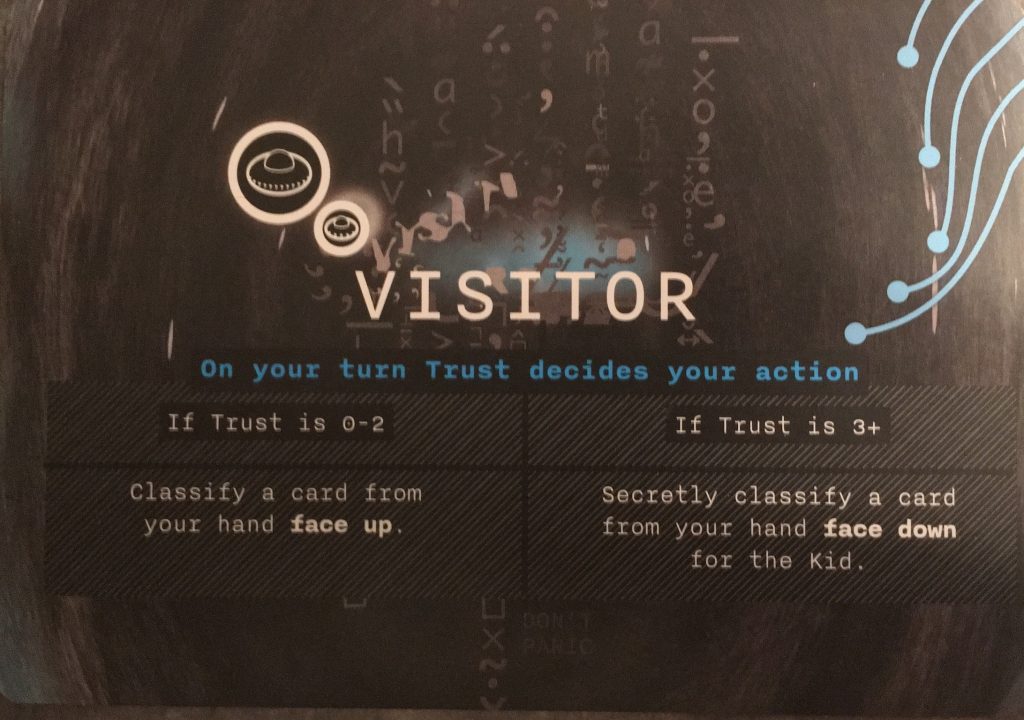
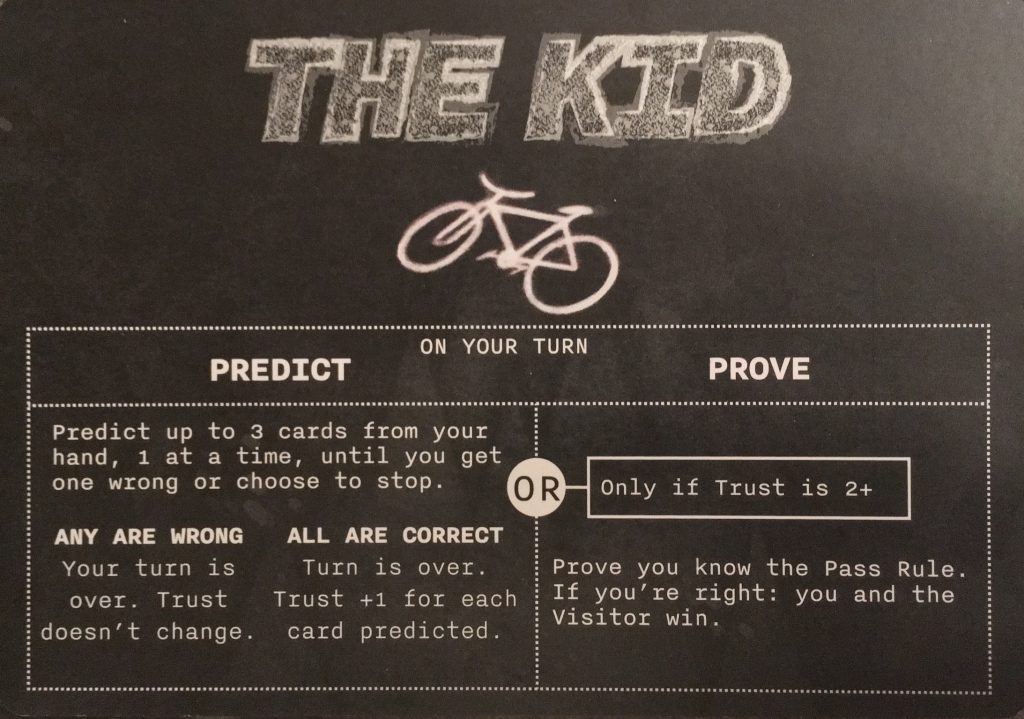
These 2 characters are working together. If the Visitor can successfully communicate what the rule is to the Kid they win. Everyone else plays the Feds – each player represents a different agency and works separately to try to guess the rule set by the Visitor.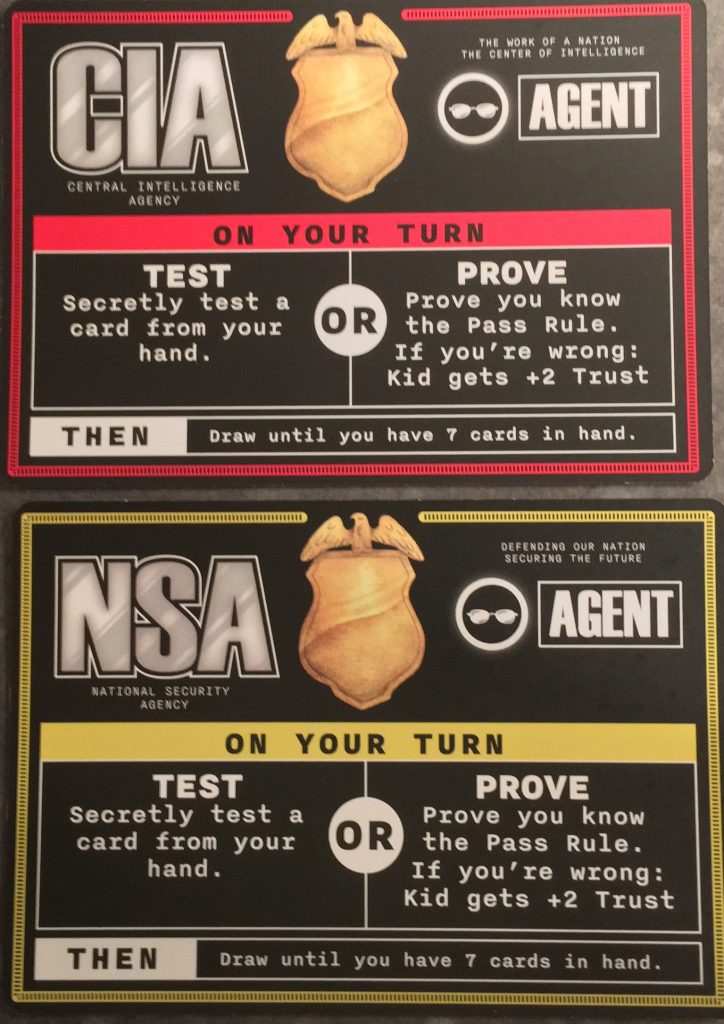
If one of the Agents guesses correctly, they win (just that one agent). If the Visitor runs out of cards, then they run out of time and all the Feds win.
Next thing that happens is the Visitor chooses a rule. The rule clearly defines what things will pass through the Forcefield (Hopefully clearly, although not always). The Visitor draws 2 cards from the image deck and either makes up a rule or chooses one from the supplied cards in the game.
 They then place the cards in the appropriate place either inside or outside the forcefield. Cards placed inside the forcefield in one of the 8 provided spots satisfy the rule. Cards placed outside the forcefield do not.
They then place the cards in the appropriate place either inside or outside the forcefield. Cards placed inside the forcefield in one of the 8 provided spots satisfy the rule. Cards placed outside the forcefield do not.
Once the Visitor has locked in their rule, image cards are distributed to all players and the game begins.
Each turn every player will try to pass objects through the forcefield. The Visitor will place them either in one of the 8 spaces inside the forcefield or in the area outside the forcefield.
At the beginning of the game the Agents pass cards facedown to the Visitor, while the Kid passes them face up. In addition to just passing cards to test the items, the Kid must announce if they think the item will make it through or not. If they are correct, the trust between the Visitor and the Kid increases, unlocking abilities and actions for them.
Increase in Trust can also force Agents to reveal their cards as well, giving the entire group more information.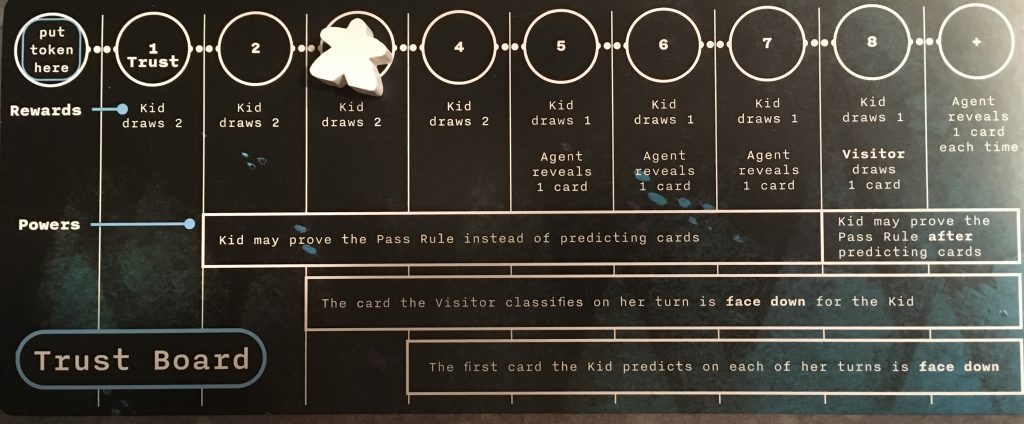
The Visitor will simply reveal one of the cards in their hand each round and place it in the appropriate place.
Once someone feels they have a handle on what the Rule is, they can test the Rule and try to win the game.
The testing player does not need to announce what the Rule is, they instead draw 4 items from the top of the deck and determine which will make it through the Forcefield and which will not. They do this by pushing the cards forward that they believe will make it through.
Before they do this, the Visitor also determines which items will pass through the Forcefield, but does so behind a screen so that the testing player cannot see. Once the player has made their guess the Visitor reveals the right answer.
If they match, game over and the testing player wins, if not, play continues.
If the Visitor runs out of cards the game ends with the Agents taking the victory.
So…What do we think?
First, let’s say this: we had a lot of fun with this one. Once you get the hang of the rules, the gameplay goes really fast and smooth. The game is in the tradition of other deduction games like Mysterium or Deception. More of the speed of Deception, but the deeper theme like Mysterium. It really resonated with us since we had grown up with E.T. (I could just feel the different agencies sneaking around being creepy).
When you are passing a card to the Visitor, the tension actually makes it feel like you are passing something through the forcefield, and when it goes through or is rejected, you get the sense of elation or sometimes puzzlement depending on what you thought would happen.
The mechanicism for testing your theory plays exactly like a game of Mastermind, except with pictures instead of colors, and with you getting more information before your next turn, less of course if the Trust between the Visitor and the Kid has risen to the point that they are passing cards face down now. Then only they are getting that information. Either way, it’s a really fun way to give more information to the players.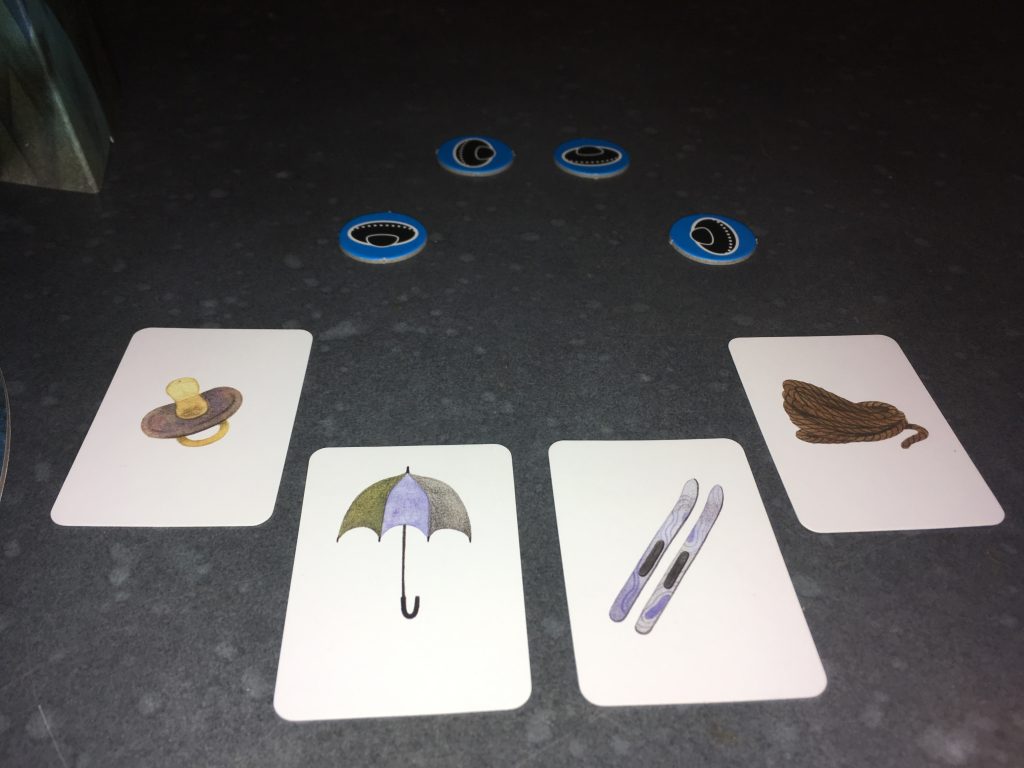
The artwork on the cards is just right. Most of the time the images are simple and can just represent one item, but sometimes you can interpret what the item is and this can greatly influence whether that item would make it through the forcefield. For instance the zeppelin is pretty straight forward unless the Rule was “contains air” or “lighter than air.” This is an extreme example but when the Visitor is trying to determine whether they fit the Rule, it can take a second and confuse the other players.
This is really the only thing that I would have to say that could maybe detract from the game. It is a little subjective. If the visitor chooses a rule that is too abstract or too specific, then it can be really hard for the Kid or the agents to successfully figure out the rule.
Luckily the game has a timer mechanism to keep it from going on forever. If the Visitor is unsuccessful in communicating the rule before running out of cards, the game ends. This effectively limits the game to about 8 rounds.
Also, it is possible for the players to test four random items, and not quite understand the rule, but still get them right. But this I don’t see as negative at all. This allows for you to still be mostly right and win. Since there is no verbal communication between the players, it would can really hard when the topic is something like “existed before 1800.” But.. if I thought that the rule was “exists in nature,” a lot of the image clues would still go through the forcefield. When this exact thing happened to us, I was able to win because the Dragon did not go through, but three animals did.
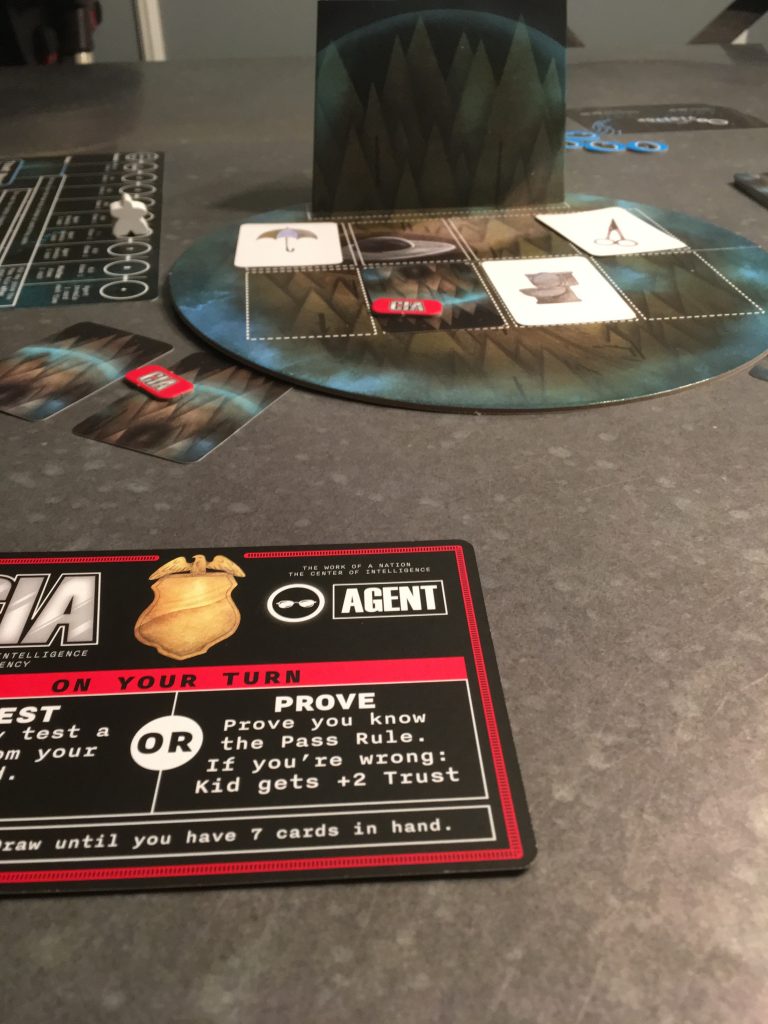 Overall I think this is a really solid game. The gameplay is fun and quick, and just thick with theme, which is awesome. The playing time is just about right. Of course, some games last longer than others, but that is to be expected. We only had a couple of games that went on way longer than we wanted, but that was usually because of an abstract or weird rule chosen by the Visitor. Either way, it is really easy to start a new game right after. This is an easy game to set up and explain, and doesn’t overstay its welcome. I can easily see it becoming a staple starter game or a closer for the end of a long night of gaming. Either way, you should probably pick this one up, you are going to be playing it for a long time.
Overall I think this is a really solid game. The gameplay is fun and quick, and just thick with theme, which is awesome. The playing time is just about right. Of course, some games last longer than others, but that is to be expected. We only had a couple of games that went on way longer than we wanted, but that was usually because of an abstract or weird rule chosen by the Visitor. Either way, it is really easy to start a new game right after. This is an easy game to set up and explain, and doesn’t overstay its welcome. I can easily see it becoming a staple starter game or a closer for the end of a long night of gaming. Either way, you should probably pick this one up, you are going to be playing it for a long time.
Ninja Approved
Visitor in Blackwood Grove was sent to us by Resonym Games in exchange for an honest review, which is exactly what we provided.
